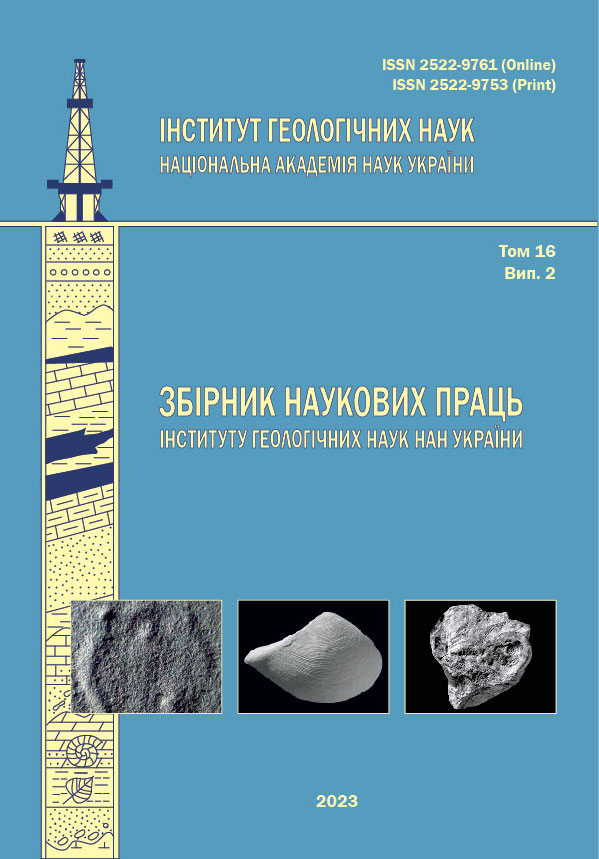ВПЛИВ АНТРОПОГЕННИХ ФАКТОРІВ НА ФОРМУВАННЯ ДОННИХ ОСАДКІВ МІЛКОВОДНИХ АКВАТОРІЙ ПІВНІЧНО-ЗАХІДНОГО ШЕЛЬФУ ЧОРНОГО МОРЯ В ГОЛОЦЕНІ ЗА ДІАТОМОВИМИ ВОДОРОСТЯМИ
DOI:
https://doi.org/10.30836/igs.2522-9753.2023.295221Ключові слова:
діатомові, Чорне море, голоцен, річковий стік, евтрофікаціяАнотація
Сучасні водні екосистеми мілководних пригирлових ділянок північно-західного шельфу Чорного моря розвиваються під дією як природних, так і антропогенних факторів. Чутливими організмами-індикаторами екологічних умов водного середовища є діатомові водорості, численні в цих водах. Мета статті — за допомогою аналізу екологічної структури діатомових комплексів із розрізів колонок новоевксинських-голоценових донних осадків виявити дію антропогенних факторів на седиментаційні обстановки пізнього голоцену. Дослідження проведено на ділянках шельфу у межах Одеської затоки та поблизу дельти Дунаю. Визначено, що специфіка сучасної седиментації та екологічні умови мілководних акваторій північно-західного шельфу залежать від рівнинного рельєфу дна, значного обсягу річкових вод і завислих наносів, зарегульованості стоку основних приток, підвищеної біопродуктивності та високого рівня антропогенного навантаження. Для досліджуваних акваторій визна‑ чено характерні види та типові співвідношення екологічних груп діатомових, які вказують на етапи голоценової трансгресії в прибережній зоні. Для відкритої Одеської затоки ознакою настання морських умов середнього-пізнього голоцену є поява літорального комплексу з домінуванням виду Paralia sulcata у планктоні. Встановлено, що діатомові комплекси з поверхневих осадків пригирлових ділянок Одеської банки та Кілійської дельти відрізняє поява планктонних і епіфітних видів-індикаторів евтрофікації та антропогенного забруднення вод. За проведеними розрахунками, такий осадок сформувався впродовж другої половини ХХ ст., коли відбулися суттєві техногенні зміни гідрологічного режиму Дніпра та Дунаю. Отже, вертикальні послідовності складу діатомових комплексів дозволили простежити не тільки природні трансформації обстановок седимен‑ тації внаслідок голоценової трансгресії, а й відповідь біотопів на антропогенні зміни. Проведені дослідження показали, що характер седиментації на мілководному шельфі змінився з другої половини ХХ ст., що стало результатом інтенсивного антропогенного впливу
Посилання
Bondarev, I. P., 2012. The main features and stages of forming the Black Sea ecosystem in the Late Pleistocene-Holocene Geology and Mineral Resources of World Ocean. No. 2 (28). Pp. 53–71. (In Russian).
Gevorgiz, N. S., Kryvenko, O. V., Kondratiev, S. I., 2005. Generalization of Long-Term Data of Chemical State in th Northwestern Part of the Black Sea during 1980–2002. Ecological safety of coastal and shelf zones and comprehensive use of shelf resources. Sevastopol. Vol. 12. Pp. 177–187. (In Russian).
Melnik, V. I., Mitin, L. I. (Eds), 1982. Geology of the UkrSSR shelf: Environment. History and methodology of study. Kyiv, Naukova Dumka. 180 p. (In Russian).
Melnik, V. I. (Ed.), 1985. Geology of the UkrSSR shelf: Litology. Kyiv, Naukova Dumka. 192 p. (In Russian).
Krishtofovich, A.N. (Ed.), 1949. Diatom analysis. Vol. 1: General and paleobotanical characteristics of diatoms. Moscow, Leningrad, State publishing house of geological literature. 240 pp. (In Russian).
Strelnikova, N. I., Tsoy, I. B. (Eds.), 2008. The Diatoms of the Russia and adjacent countries: Fossil and recent. Vol. ІІ, issue 5. St. Petersburg University press. 170 p. (In Russian)
Makarova, I. V. (Ed.), 1988. The Diatoms of the USSR: Fossil and recent. Vol. ІІ, fasc. 1. Leningrad, Nauka. Leningrad branch. 116 p. (In Russian).
Jousé, A. P., 1953. To the technique of technical processing of rocks for the purpose of diatom analysis. Diatom collection of papers. Leningrad. Pp. 206–220. (In Russian).
Lomakin, I. E., Pokaliuk, V. V., Kochelab, V. V., 2016. Neotectonic activity and landslide processes in the coastal zone of the NW Black Sea. Geology and Mineral Resources of World Ocean. Vol. 12, iss. 3. Pp. 95–99. (In Russian). https://doi.org/10.15407/ gpimo2016.03.095
Malakhov, I. N., Alekhina, T. N., Ivanchenko, V. V., Bobko, A. A., Zhuravel, N.R. The formation of bottom sediments in the mouth areas of the Dnieper-Bug estuary rivers under conditions o anthropogenic load. Geology and Mineral Resources of World Ocean. 2010. No. 2 (20). Pp. 69–78. (In Russian).
Mitropolsky, A. Yu., Olshtynsky, S. P., Usenko, V. P., 1977. Some features of the material composition of bottom sediments in the western part of the Black Sea. Kyiv. Institute of Geochemistry and Physics of Minerals, AS of the UkrSSR. 68 pp. (Preprint IGFM 77). (In Russian)
Moroz, S. A., Mitropolsky, A. Yu., 1988. Model of marine silica accumulation. Kyiv. 37 p. (Institute of Geological Sciences, Preprint 88–36). (In Russian).
Nasedkin, Ye. I., Mitropolskyi, O. Yu., Ivanova, G. M., 2013. Monitoring of sedimenation processes in the zone of land-sea interaction. Sevastopol. 295 p. (In Ukrainian).
Mitropolsky, A. Yu. (Ed.), 1987. Some features of sedimentation in the northwestern part of the Black Sea. Kyiv. 55 pp. (Institute of Geological Sciences, Preprint 87–10). (In Russian).
Omelchuk, A. V., Kovalev, S. B., Gevorkyan, V. Kh., Semenov, D. V., Ivanov, V. E., 1999. The influence of anthropogenic factors on the formation of bottom geoecological landscapes. Geology and mineral resources of the Black Sea. Pp. 247–251. (In Russian).
Tyuleneva, N. V., 2014. Late-pleistocene — Holocene sediment accumulation in the Northwestern Black sea shelf. Odesa National University Herald. Geography and Geology. Vol. 19, No. 4. Pp. 272–283. (In Russian). https://doi. org/10.18524/2303-9914.2014.4(23).39382.
Simоv, V. G., 2014. River Runoff in the Black Sea. Scientific works of the Ukrainian scientific and research hydrometeorological institute [Naukovi pratsi Ukrayinskoho naukovo-¬doslidnoho hidrometeorolohichnoho instytutu] Vol. 266. Pp. 62–69. (In Russian).
Khilchevskyi, V.K., Grebin, V. V., 2022. Water objects of Ukraine and recreational assessment of water quality. Kyiv: DIA. 240 p. (In Ukrainian).
Shreider, A. A., 2008. Formation of the deep-sea basin of the Black Sea. Abstract of the candidate’s thesis (Geol.-Min. Sci.). Moscow. (In Russian).
Shuisky, Y. D., 2003. Hydro-morphological characteristics of evolution of contemporary Kiliya delta of Danube river. Odesa National University Herald. Vol. 8, No.11. Pp. 4–17. (In Russian).
Shuiskyi, Yu.D., 2007. Natural and artificial factors of influence
on the Danube delta system. Geopolitics and eco-geodynamics
of regions [Geopolitika i ekogeodinamika regionov]. Vol. 2.
Pp. 76–80. (In Ukrainian).
Bilous, O. P., Genkal, S. I., Zimmermann, J., Kusber, W.-H.,
Jahn, R., 2021. Centric diatom diversity in the lower part of the
Southern Bug river (Ukraine): the transitional zone at Mykolaiv
city. PhytoKeys. Vol. 178. Pp. 31–69. (In Ukrainian). https://
doi. org/10.3897/phytokeys.178.64426.
Cociasu, A., Dorogan, L., Humborg, C., Popa, L., 1996. Longterm ecological changes in Romanian coastal waters of the
Black Sea. Mar. Pollut. Bull. Vol. 32, iss.1. Pp. 32–38. https://
doi.org/10.1016/0025–326X(95)00106-W
Genkal, S. I., Kulikovskiy, M. S . , Ku z n e t s ov a ,
I . V. , 2 0 2 0 . T h e r e c e n t f r e s h w a t e r c e n t r i c
diatoms of Russia. Yaroslavl, Filigran, 433 p.
URL: https://www.researchgate.net/publication/348352056_
The_recent_freshwater_sentric _diatoms_of_Russia
(In Russian).
Guiry, M. D., Guiry, G. M., 2021. AlgaeBase. World-wide
electronic publication. National University of Ireland, Galway.
URL: https://www.algaebase.org.
Humborg, C., Ittekkot, V., Cociasu, A., von Bodungen, B., 1997.
Effect of Danube river dam on Black Sea biogeochemistry and
ecosystem structure. Nature. Vol. 386. Pp. 385–388. https://
doi.org/10.1038/386385a0.
Kulikovskiy, M. S., Glushchenko, A. M., Genkal, S. I., Kuznetsova,
I. V., 2016. Identification book of diatoms from Russia.
Yaroslavl, Filigran. 804 p. URL: https://www.researchgate.
net/publication/328631177_Identification_ book_of_diatoms_
from_Russia (In Russian).
Mousing, E. A., Adjou, M., Ellegaard, M., 2015. Evidence of
intensified biogenic silica recycling in the Black Sea after 1970.
Estuarine, Coastal and Shelf Science. Vol. 164. Pp. 335–339.
http://doi.org/10.1016/ j.ecss.2015.07.031
Oguz, T., 2005. Long-Term Impacts of Anthropogenic Forcin
on the Black Sea Ecosystem. Oceanography. Vol. 18, No. 2.
Pp. 112–121. https://doi.org/10.5670/oceanog.2005.46
Olshtynskaya A. P., Tymchenko Yu. A., 2014. Fossil Holocene
Diatoms of the Karkinit Bay, the Black Sea, Ukraine.
International Journal on Algae. Vol. 6, No. 2. Pp. 193–206.
https://doi.org/10.1615/InterJAlgae.v16.i2.90
BSC, 2008. State of the Environment of the Black Sea (2001–
/7). Ed. by Temel Oguz. Publications of the Commission on
the Protection of the Black Sea Against Pollution (BSC) 2008–3,
Istanbul, Turkey, 448 p. URL: http://www.blacksea-commission.
org/_publ-soe2009.asp#_Toc226518004.
BSC, 2019. State of the Environment of the Black Sea (2009–
/5). Ed. by Anatoly Krutov. Publications of the Commission
on the Protection of the Black Sea Against Pollution (BSC)
, Istanbul, Turkey, 811 p. URL: http://www.blackseacommission.org/Inf.%20and%20Resources/Publications/
SOE2014/.
Vos, P. C., De Wolf, H., 1988. Methodological aspects of
paleoecological diatom research in coastal areas of the
Netherlands. Geol. Mijnbouw. Vol. 67. Pp. 31–40.
Vos, P.C., De Wolf, H., 1993. Diatoms as a tool for reconstructing sedimentary environments in coastal wetlands; methodological aspects. Hydrobiologia. Vol. 296/270. Pp. 285–296. https:// doi.org/10.1007/BF00028027
Vos, P. C., De Wolf, H., 1994. Palaeoenvironmental research on diatoms in Early and Middle Holocene deposits in Central North Holland (The Netherlands). Netherlands Journal of Aquatic Ecology. Vol. 28 (1). Pp. 97–115. https://doi.org/10.1007/ BF02334250
Witkowski, A., Lange-¬Bertalot, H., Metzeltin, D., 2000. Diato flora of marine coasts I. In: Iconographia diatomologica. Vol. 7. Lange-¬Bertalot, H. (ed.). Ruggell, Liechtenstein, A.R.G. Gantne Verlag K. G. 925 p.
Yunev, O. A., Konovalov, S.K., Velikova, V., 2019. Anthropogenic eutrophication in the Black Sea pelagic zone: long-term trends, mechanisms, consequences. (In Russian). https:// doi:10.34756/GEOS.2019.16.37827. URL: https://core.ac.uk/ reader/304111950.
Zelnik I., Germ M., Golob A., Krivograd Klemenčič A., 2023. Differences in Phytobenthic Diatom Community between Natural and Channelized River Sections. Plants. Vol. 12. P. 2191. https://doi.org/10.3390/plants12112191.


